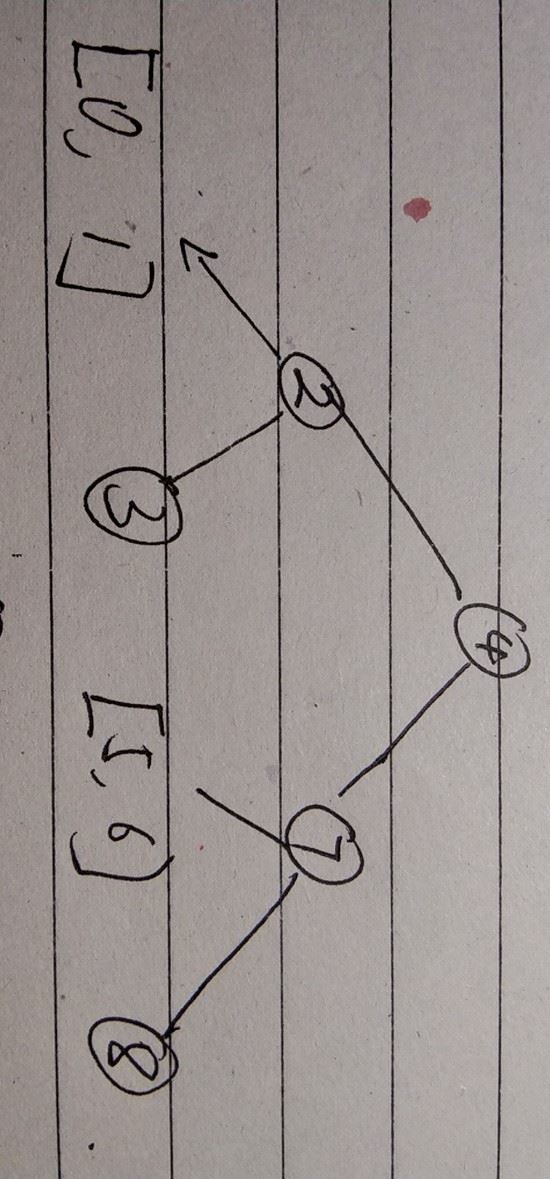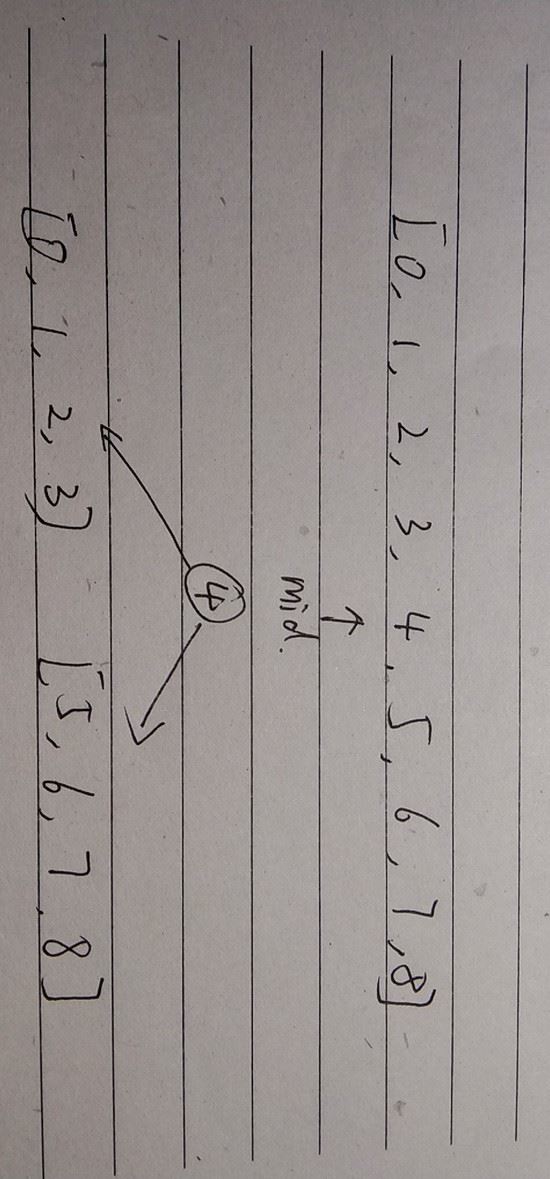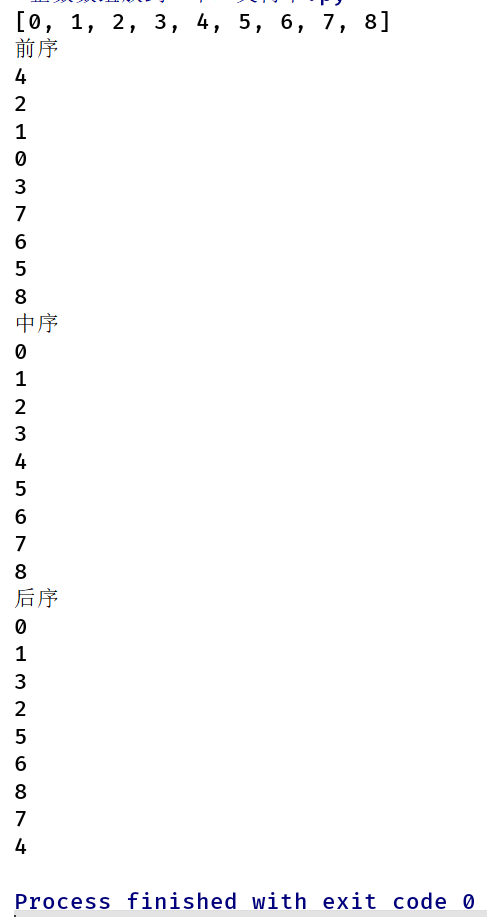题目:将[0,1,2,3,4,5,6,7,8,9,10]存储到二叉树,原数组有序,转换为二叉排序树。
二叉排序树的特点:当前节点的左子树上的所有节点都小于该节点,右子树上的所有节点都小于该节点。
二叉排序也称为二叉查找树。
我的实现思路:
取有序数组的中间节点作为根节点,将数组分为左右两个部分,对左右两个子数组做相同的操作,递归的实现。
图示:

1

2

3
代码实现:
|
1
2
3
4
5
6
7
8
9
10
11
12
13
14
15
16
17
18
|
def array_to_bitree(array): #判断arr是否为空 if len(array)==0: return bitnode(array[0]) mid=len(array)//2 # 有序数组的中间元素的下标 #print(mid) #start=0 # 数组第一个元素的下标 #end=-1 # 数组最后一个元素的下标 if len(array)>0: #将中间元素作为二叉树的根 root=bitnode(array[mid]) #如果左边的元素个数不为零,则递归调用函数,生成左子树 if len(array[:mid])>0: root.left_child = arraytobitree(array[:mid]) #如果右边的元素个数不为零,则递归调用函数,生成左子树 if len(array[mid+1:])>0: root.right_child = arraytobitree(array[mid+1:]) return root |
我们调用前面写的三种遍历方法看一看,我们构造的树是否正确:
|
1
2
3
4
5
6
7
8
9
10
11
12
13
14
15
16
17
18
|
#将[0,1,2,3,4,5,6,7,8,9,10]存储到二叉树if __name__ == '__main__': #先构造一个有序数组、链表 arr=[] for i in range(10): arr.append(i) print(arr) #调用函数 bt=arraytobitree(arr) #前序遍历二叉树 print("前序") print_tree_pre_order(bt) # 中序遍历二叉树 print("中序") print_tree_mid_order(bt) # 后序遍历二叉树 print("后序") print_tree_after_order(bt) |
输出:

根据这三种遍历结果可以判断出二叉树的结构,结果和前面的是一样的,代码如下:
|
1
2
3
4
5
6
7
8
9
10
11
12
13
14
15
16
17
18
19
20
21
22
23
24
25
26
27
28
29
30
31
32
33
34
35
36
37
38
39
40
41
42
43
44
45
46
47
48
49
50
51
52
53
54
55
56
57
58
59
60
61
62
63
64
65
66
67
68
69
70
71
72
73
74
75
76
77
78
79
80
81
82
83
84
85
86
87
88
89
90
91
92
93
|
#定义二叉树结点类型class bitnode: """docstring for bitnode""" def __init__(self,arg): self.data = arg self.left_child = none self.right_child = none#前序遍历def print_tree_pre_order(root): #先判断二叉树是否为空 #if root.left_child is none and root.right_child is none: if root is none: return root #先根 print(root.data) #再左 if root.left_child is not none: print_tree_pre_order(root.left_child) #再右 if root.right_child is not none: print_tree_pre_order(root.right_child)#中序遍历二叉树def print_tree_mid_order(root): #先判断二叉树是否为空,当左右节点都为空时 if root is none: return #中序遍历 左根右 #遍历左子树 if root.left_child is not none: print_tree_mid_order(root.left_child) #遍历根节点 print(root.data) #遍历右子树 if root.right_child is not none: print_tree_mid_order(root.right_child)#后序遍历def print_tree_after_order(root): #先判断二叉树是否为空 if root is none: return root #再左 if root.left_child is not none: print_tree_after_order(root.left_child) #再右 if root.right_child is not none: print_tree_after_order(root.right_child) #先根 print(root.data)def array_to_bitree(array): #判断arr是否为空 if len(array)==0: return bitnode(array[0]) mid=len(array)//2 # 有序数组的中间元素的下标 #print(mid) #start=0 # 数组第一个元素的下标 #end=-1 # 数组最后一个元素的下标 if len(array)>0: #将中间元素作为二叉树的根 root=bitnode(array[mid]) #如果左边的元素个数不为零,则递归调用函数,生成左子树 if len(array[:mid])>0: root.left_child = array_to_bitree(array[:mid]) #如果右边的元素个数不为零,则递归调用函数,生成左子树 if len(array[mid+1:])>0: root.right_child = array_to_bitree(array[mid+1:]) return root #将[0,1,2,3,4,5,6,7,8,9,10]存储到二叉树if __name__ == '__main__': #先构造一个有序数组、链表 arr=[] for i in range(9): arr.append(i) print(arr) #调用函数 bt=array_to_bitree(arr) #前序遍历二叉树 print("前序") print_tree_pre_order(bt) # 中序遍历二叉树 print("中序") print_tree_mid_order(bt) # 后序遍历二叉树 print("后序") print_tree_after_order(bt) |
以上就是本文的全部内容,希望对大家的学习有所帮助,也希望大家多多支持服务器之家。
原文链接:https://www.jianshu.com/p/b7492d68a39f










